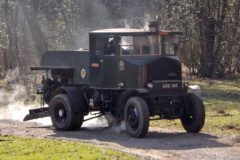1985 Volvo F10 restored
Posted by Chris Graham on 29th April 2021
While looking pretty good when he bought it, Wayne Blake’s 1985 Volvo F10 was a different story under the skin, as Peter Simpson explains.
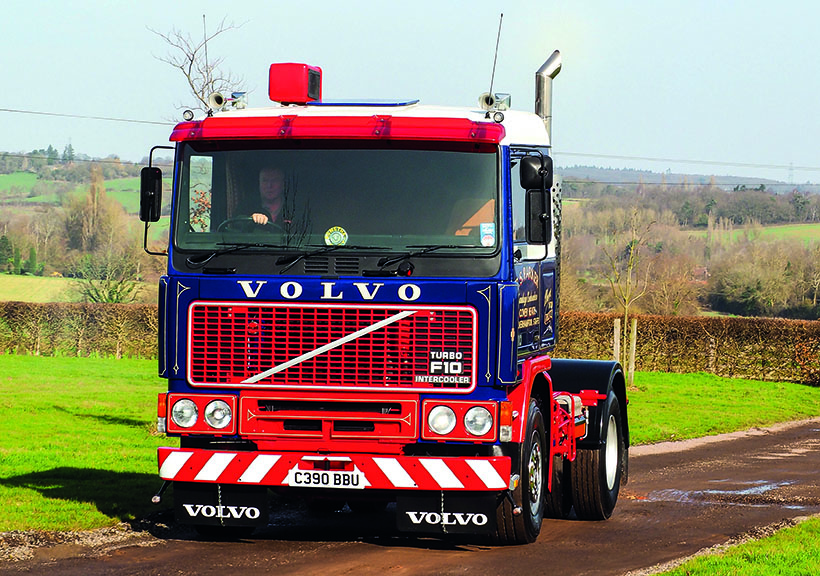
A 1985 Volvo F10 restored.
Most of the restorations that we feature involve, basically, transforming a vehicle from rough condition into anything from a good working lorry, to a top-end prize-winner. In almost all cases, however, the difference between before and after also tends to be pretty obvious. This one, however, is slightly different.
The lorry looked pretty good when it was purchased and, compared with some we see, the external appearance hasn’t changed massively during the restoration. For example, the cab retains not only the same paint-finish, but also the same signwriting…
Please, though, don’t for a moment imagine that this has been in any way a quick, superficial, or easy restoration. Rather, look a little closer, and it’s obvious that it’s been a big, thorough and extremely well-executed job. Much of the work has centred on areas that, although less visible, are actually rather more important than a coat of shiny paint.
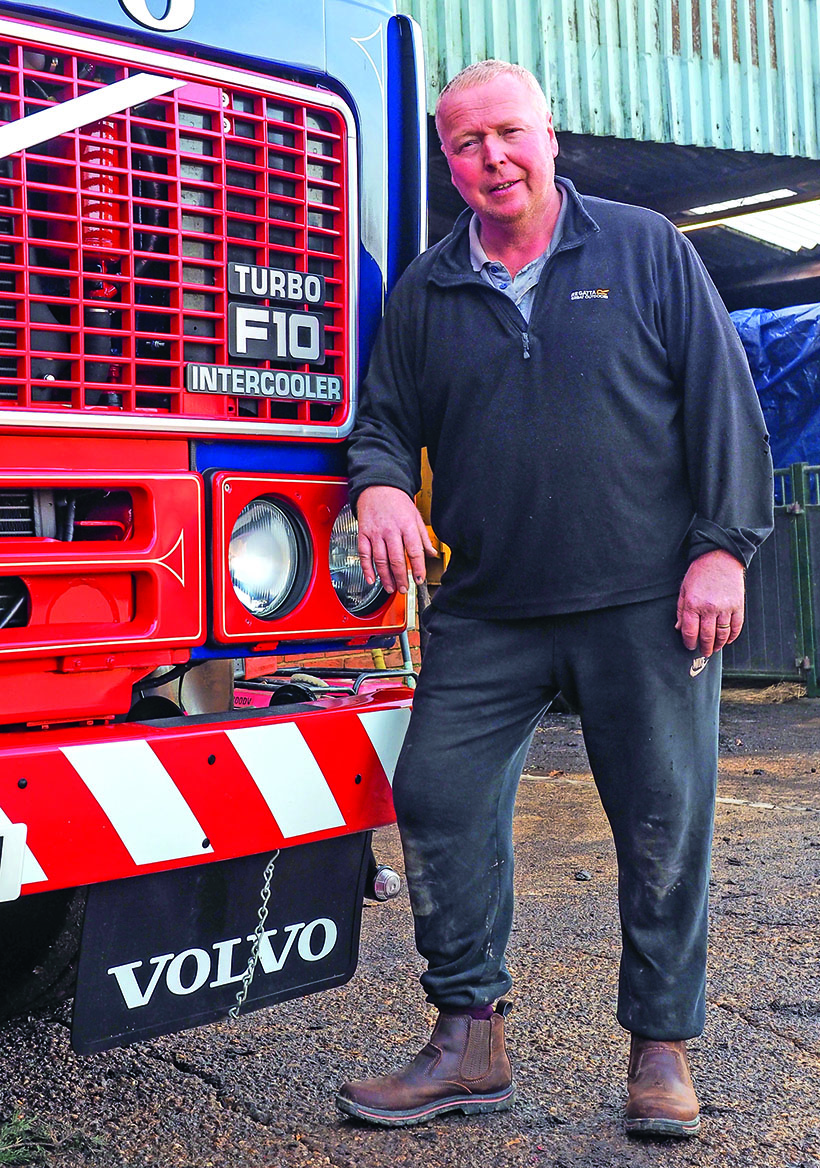
Wayne Blake is justifiably pleased with the results of his restoration work.
Life with lorries
First, though, a brief ‘owner profile’. Aged 57 and based just outside Colchester, Wayne Blake has had lorries around him for his entire life. His father, Michael – still alive and still very interested in lorries – was a commercial and agricultural engineer who subsequently diversified into running his own farm, with a haulage business alongside it.
The haulage business dealt mainly with transportation of agricultural materials, such as animal feeds, hay and straw, and tended to run older lorries. Consequently, Wayne grew up surrounded by various Bedford TKs, Ford D-Series, Atkinsons and the like. He also went into ‘the business’ after leaving school although, to gain experience, he began by working on another, larger, farm on Mersea Island.
It was there, in the early 1980s, that he encountered a Volvo F10 for the first time, when a local sheep dealer called by with one, and Wayne was star-struck! This new, state-of-the-art lorry was light years away from the older stuff he’d been used to! It looked, in his words “knockout.”
In due course, Wayne returned to the family business (“and reality”). As soon as he turned 21, he started training for his HGV licence with RTT Training of Mendlesham which, at the time, was using a couple of Leyland Freighters that had been turned into tractor units. These, rather unusually for training vehicles by that stage, had non-synchromesh (crash) gearboxes. But Wayne mastered this, and went on to pass his Class 1 HGV at the first attempt.

The engine is now resplendent in the correct shade of Volvo engine light green.
At about this point, the farm’s first tractor unit arrived; a DAF 2100, with a Scania 112 and Volvo FL10 subsequently being bought. Additionally, the family – chiefly through Dad’s interest – began to assemble a collection of interesting, preserved vehicles. Many of these, including a Thames Trader and a TS3-engined Commer, are still owned. The best-known, though, is probably LCE 500; a Morris Commercial FV53 that was restored to a high standard, and a familiar sight on the rally scene for many years.
Wayne, unsurprisingly, became involved with the family collection, and gradually took more and more responsibility, including taking the vehicles to rallies. He was, however, keen to expand its ‘age range’ to include a vehicle or two from his era and, given that first impression on Mersea Island nearly 40 years earlier, a Volvo F10 was pretty high on his list of preferences!
Price on application
The next bit was, in Wayne’s words: “CVC’s fault”, as C390 BBU was actually advertised in the magazine’s October 2018 issue. Two things, though, put him off. One was the price being listed as ‘POA’; the other being that the photograph wasn’t particularly good. All the same, he made the call, and ended up having “a lovely chat” with its owner who was Wolverhampton-based Bruce Parker. The upshot of this was that Wayne, together with his wife, Tracey, took a trip to the West Midlands.
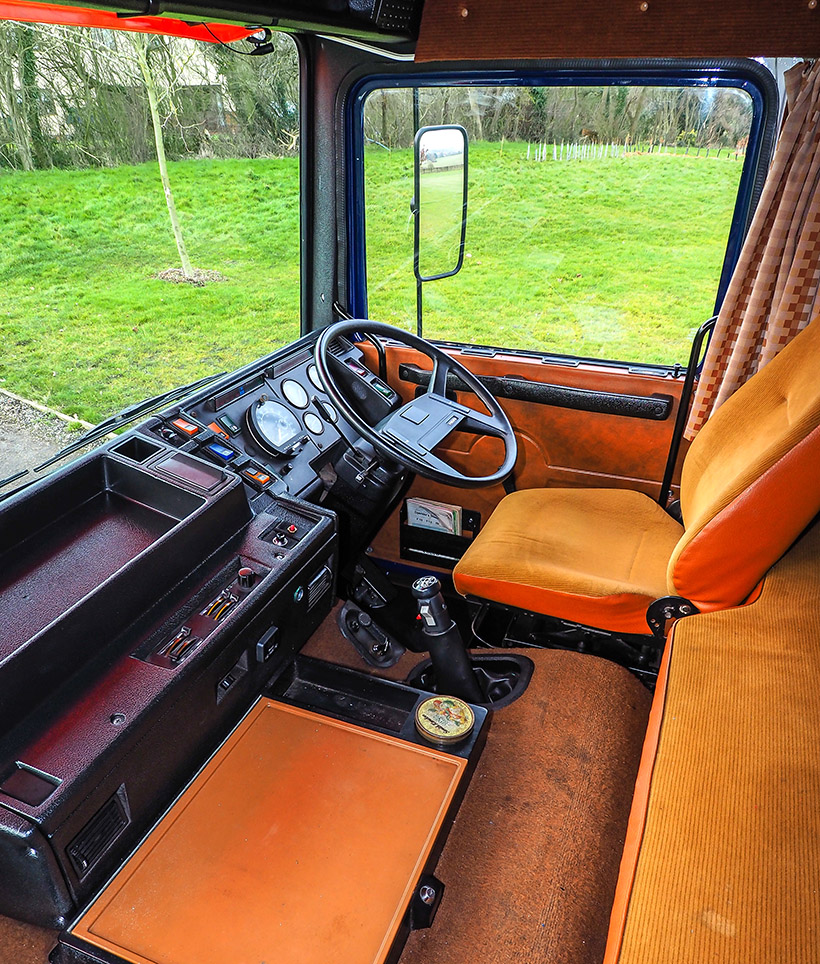
The cab interior has been fully refurbished, and is now as close as possible to the original factory-spec.
Wayne says: “I needed it to wow me and, when I got there, it did!” In particular, the usually rather rot-prone cab looked to be in good order. In fact, the lorry overall was good though, as always, areas with room for improvement could be seen. The F10 was said to have had “some significant restoration work carried out, about 12 years earlier.”
Needless to say, Wayne agreed to buy, borrowing part of the price from a mate on “easy terms”, then returned a couple of weeks later to drive the Volvo back home on trade plates. One problem revealed itself pretty-much straightaway, though; the gearbox splitter wasn’t working, and it was clear that the mechanical side generally was a little tired.
Unfortunately, the previous owner knew next to nothing of the F10’s history. However, since its purchase, Wayne has researched it extensively, and now thinks he has pretty-much the full picture. Here too, this lorry’s story is a bit different from most that survive into preservation, due to leading relatively easy working lives with a small number of owners.

Wayne at the wheel. The gear splitter is now fully operational once again.
The lorry has had nine previous owners according to the V5C and, although its working life has been somewhat varied, it’s been anything but easy. It was new to Kammak International, a Rochdale-based company. When or why it moved on isn’t certain, but the next owner was Applegate Rentals, under whom it seems to have spent much of the time being rented to a woman driver named Jo Anderson, who used it mainly for continental work, collecting produce for Safeways. France, Spain and Italy were her frequent destinations.
Wayne is now in contact with Jo, and she’s seen the finished Volvo several times, but we’ll come back to that later. Meanwhile, after Applegate sold it, the Volvo moved to Bristol, where it was first operated on container work by Larry Joyce, and then by a scrap dealer.
The next owner was… Jo Anderson! She had, by all accounts, become rather attached to her old Volvo through driving it so much. She managed to track it down, was able to buy it and then took it back home to Scotland. Some restoration work followed to return what had become a rather down-at-heel-looking vehicle, to presentable condition.
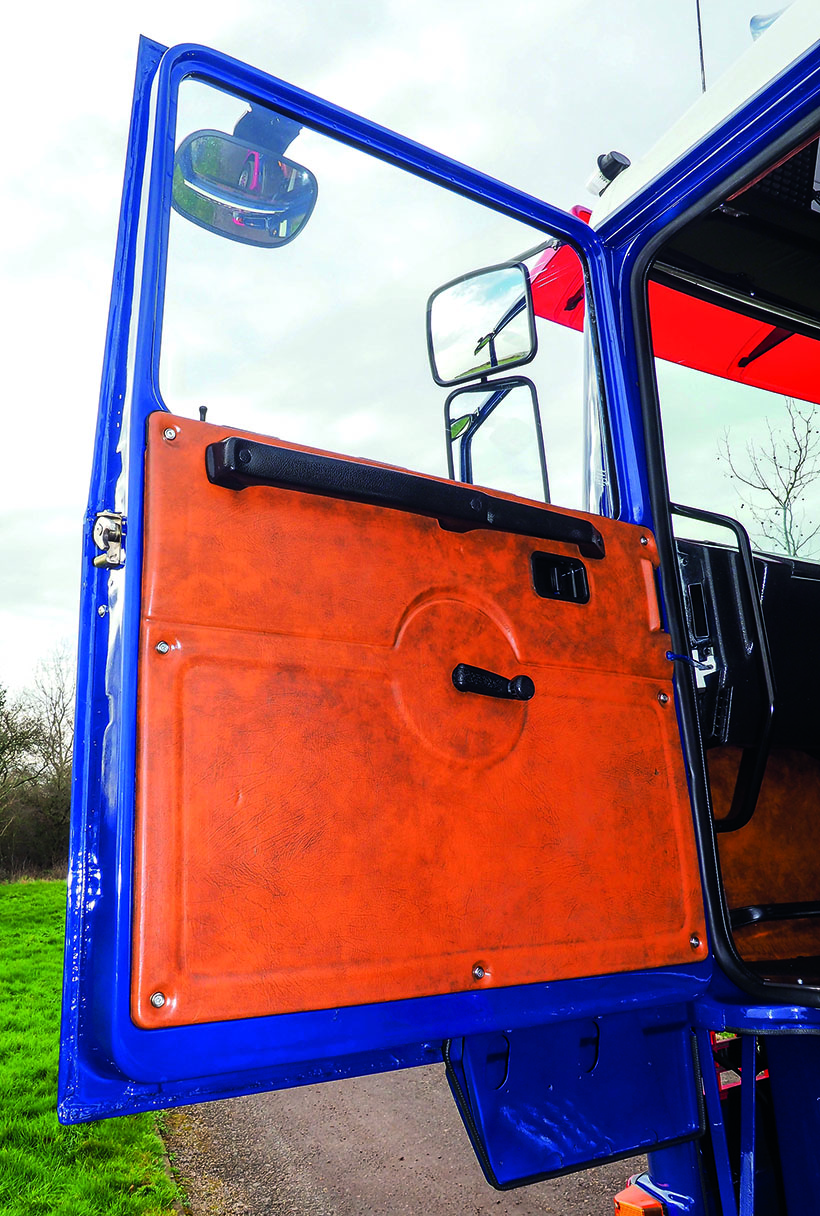
The original, brown door cards were rediscovered underneath later ‘retrimming’.
Then, having secured the Volvo’s future, Jo passed the lorry on to Robert Laidlaw who, apparently, downgraded it from 38 tonnes to 32, and treated it as ‘semi-preserved’ – it was used on a local, ‘niche job’ of some kind, while also being treated as something of a pet. The next owner was Bruce Parker, from whom Wayne bought it.
Once the Volvo was in Wayne’s ownership, some general improvements were undertaken over the winter of 2018-19, and the lorry was rallied a little during 2019.
Work starts!
Then, between Christmas and New Year 2019-20, work started on the restoration. One aspect which Wayne was keen to recreate was the classic green look for the Volvo 300 power unit, so the stripdown began with the engine and gearbox coming out, and the front of the chassis being stripped and blasted. At this point, the intention was that the Volvo would be out on the show circuit during 2020, so only the front half of the chassis – up to the diesel tank – was stripped at that stage. The cab wasn’t removed, but was tilted fully forward and thoroughly masked and sheeted. The front hubs also came off and were stripped, cleaned and rebuilt.
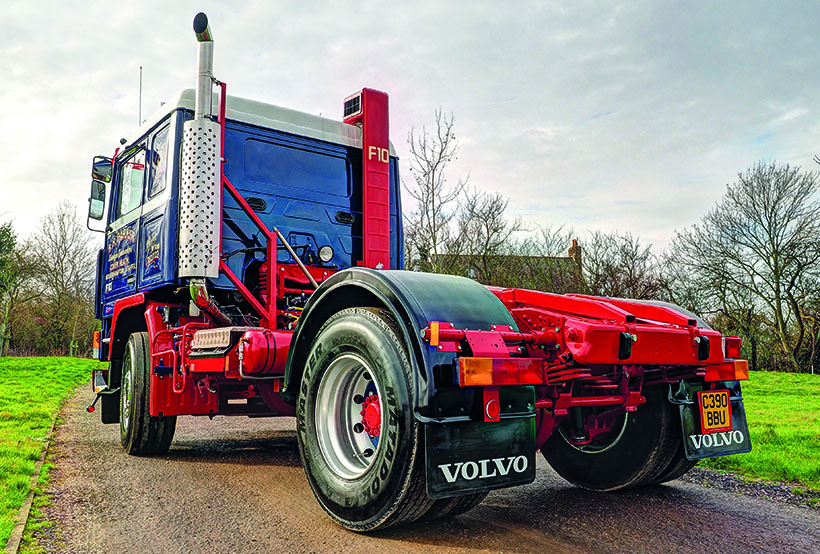
The engine was cleaned-up, and removal of the valve chest covers revealed a broken valve spring, which had to be renewed, together with the front and rear crankshaft seals. The compressor also needed renewing. With the gearbox, Wayne got the splitter sort-of working by “fiddling with it a bit!” It wasn’t, however, 100% satisfactory, and he ended up sending the ‘box away for professional rebuild – this was just about the only part of the job which he and his helpers didn’t tackle themselves. The complete power unit was then repainted in the correct, Volvo green that Lee remembered.
At this point, we need to name-check a few people who helped with the project. Starting with Lee Peck, an extremely experienced and adaptable fixer of lorries who Wayne has known for many years; and who can turn his hand to anything from spannering to spraying. Oh, and Lee’s also pretty good at finding obscure stuff online!
Others worthy of note include Jeff at Volvo dealership, Duffields of Ipswich (“phenomenal at finding and sourcing parts from everywhere”), Mick Farrow of Great Yarmouth, who has worked on Volvos for many years, and is particularly adept at sorting wiring issues, “Frank from Ipswich”, who worked on F10s back in the day, and Wiltshire-based Jason Dean, who was an excellent source of good, secondhand parts.
Back with the job, the twin-plate clutch was in a very bad way, with broken rivets and a worn thrust bearing, so a rebuilt unit was installed. The radiator needed renewing, and new intercooler brackets were also required, but not available, so the team fabricated replacements from scratch. Pretty much all the air pipes were also renewed, and the front-axle strip-down revealed odd brake chambers and slack adjusters – those on one side being from a trailer! The shoes, by contrast, were like new.
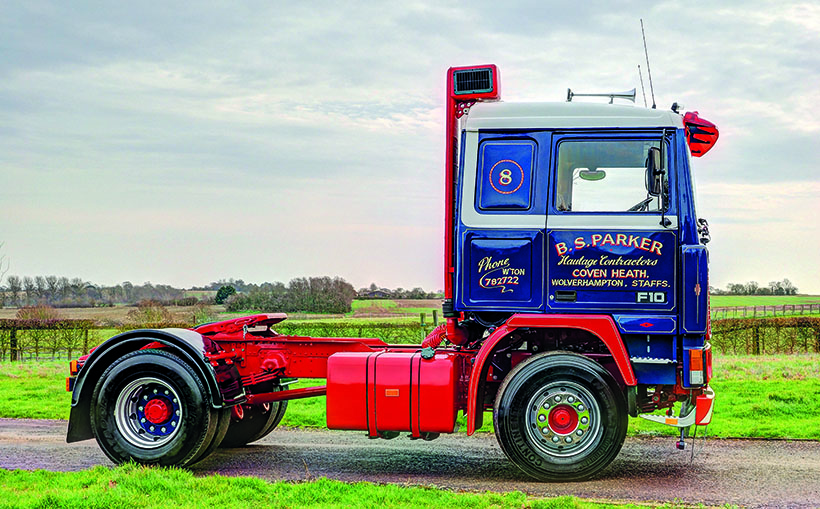
I mentioned a moment ago that ‘expertise’ was available when it came to electrics, which is a good job as the wiring loom turned out to be in a terrible state. It had, as on most older working lorries, been cut into, adapted and ‘modified’ on many occasions. There was also the expected, age-related deterioration. The loom was removed and fully refurbished – a process that took a full three days to complete – but everything is now working as it should.
A problem…
With everything back together, it was time to try the refurbished drivetrain in action. There was, though, a snag. The engine started and ran fine, but the clutch was solid, wouldn’t disengage and it was impossible to select gears. Wayne subsequently discovered that the rebuilt clutch incorporated right-angle brackets between the plates, which have been bent flat before installation and, of course, putting this right meant the gearbox had to come off again.
As noted earlier, the cab was in remarkably good condition, having been attended to extensively in the past. Wayne noticed, however, that a lot of the panels around the front had not been painted on the inside, so this was rectified. The cab heater – one of many areas in which, sadly, Volvo trucks scored over their British-built rivals – wasn’t working, and the cause turned out to be internal corrosion of several key, but relatively small aperture, pipes. Also on a coolant theme, the low water probe wasn’t working – the cause turned out to be a missing relay. Which, fortunately, was the same as one used on some Scania ‘Bendy Buses.’
The cab interior “looked OK” when Wayne bought the lorry, but he also knew that it wasn’t right. Pretty-much everything had been retrimmed with a brown, fake-leather material that was lighter-coloured than the original. Wayne was unsure what to do about this until, when he came to strip the driver’s door trim out to replace the window winder, he found the original interior trim panel under the leather, and still in very good condition!
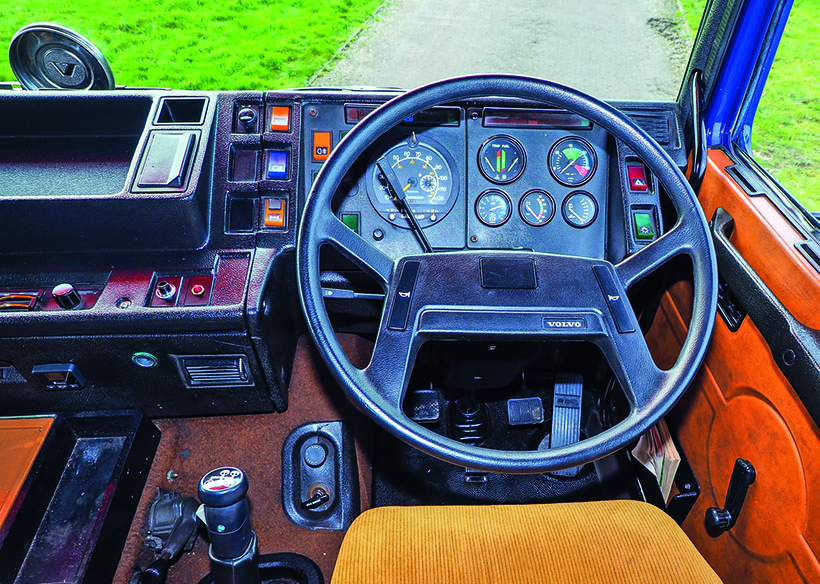
So, after much internet searching, Lee sourced material of the correct colour to trim the rest, from a firm in Holland. The cab interior is now as original and period-correct as possible – even down to having (only) the factory-fit radio and an operational night-heater. It does, though, differ in one respect now from how it was built; the rear panel is now all-metal whereas, originally, it contained a window.
And that, basically, is where things are now. Since our photo session, the original headlamp wash-wipe has been reinstated and, although a few minor finishing touches/shakedown jobs remain, the project is basically as complete as these things ever are. The family have taken part in the HCVS London-Brighton Run many times in the past, and were hoping to debut the F10 at the 2021 event. That, though, is now off until 2022, and the family team are currently looking at what else they can do this year – including, hopefully, the Sevenoaks to Hastings Sprat & Winkle Run, in October.
For a money-saving subscription to Classic & Vintage Commercials magazine, simply click here




